当前位置:网站首页>STM32 summary (HAL Library) - DHT11 temperature sensor (intelligent safety assisted driving system)
STM32 summary (HAL Library) - DHT11 temperature sensor (intelligent safety assisted driving system)
2022-07-05 08:16:00 【IOT Xiaokai】
DHT11 Introduce
DHT11 Digital temperature and humidity sensor is a temperature and humidity composite sensor with calibrated digital signal output , It uses special digital module acquisition technology and temperature and humidity sensing technology , Ensure that the product has high reliability and excellent long-term stability . The sensor consists of a resistive humidity sensor and a NTC Temperature measuring element , And with a high performance 8 Bit single chip microcomputer connected . So this product has excellent quality 、 Super quick response 、 Strong anti-interference ability 、 High cost performance advantages . Every DHT11 Sensors are calibrated in a very accurate humidity calibration room . The calibration factor exists in the form of a program OTP In the memory , These calibration coefficients should be called in the process of detecting the model inside the sensor . Single line serial interface , Make system integration easy and fast . Super small size 、 Very low power consumption , Make it the best choice for even the most demanding applications . Products for 4 Single row pin package , Easy to connect .
DHT11 working principle
2.1、DHT11data data format : ( High first out )
Primary transmission 40 Bit data =8bit Humidity integer data + 8bit Humidity decimal data + 8bit Temperature integer data + 8bit Temperature decimal data + 8bit The checksum . When the data transmission is correct , The checksum data is equal to “8bit Humidity integer data +8 Humidity decimal data +8bit Temperature integer data +8bit Temperature decimal data ” The end of the result 8 position .
user MCU After sending a start signal ,DHT11 Switch from low power consumption to high speed mode , Wait for the end of the host start signal ,DHT11 Send a response signal , Send out 40bit The data of , And trigger a signal acquisition , Users can choose to read some data , From mode ,DHT11 Receive the start signal to trigger a temperature and humidity acquisition , If no start signal is received from the host ,DHT11 Do not actively collect temperature and humidity , After collecting data, switch to low speed mode .
2.2、 Sequential programming
Starting timing
The bus idle state is high , The host pulls down the bus and waits DHT11 Respond to , The host must pull the bus lower than 18 millisecond , Guarantee DHT11 Can detect the start signal .DHT11 After receiving the start signal from the host , Wait for the host start signal to end , And then send 80us Low level response signal . After the host sends the start signal , Delay waiting for 20-40us after , Read DHT11 The response signal , After the host sends the start signal , You can switch to input mode , Or the average output high power can , The bus is pulled up by a pull-up resistor .
Data receiving timing
The bus is low , explain DHT11 Send a response signal ,DHT11 After sending the response signal , Then pull up the bus 80us, Prepare to send data , each bit All the data are based on 50us The low level slot starts , The length of the high level determines that the data bit is 0 still 1. The format is shown in the figure below . If the read response signal is high , be DHT11 No response , Please check whether the line is connected properly . When the last one bit After the data is transmitted ,DHT11 Pull down the bus 50us, Then, the bus is pulled up by the pull-up resistance and enters the idle state .
Numbers 0 Signal representation 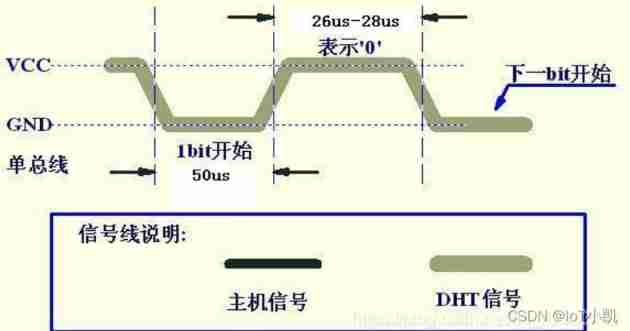
Numbers 1 Signal representation 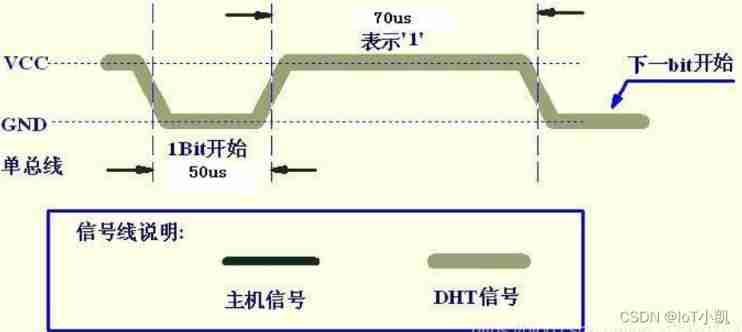
*DHT11 Code
3、DHT11 Communication process and code
3.1、 Simple communication process
Step 1 initialization IO mouth Complete the starting sequence Check DHT11 Whether there is
The signal line of the second host is pulled up to receive data , Receive... In turn 40 position
3.2 The main program part
dht11.c Part of the code *
#include "delay.h"
#include "dht11.h"
#include "tim.h"
#define DHT11_DQ_IN HAL_GPIO_WritePin(GPIOC, DHT11_DATA_OUT_Pin, GPIO_PIN_SET) // Input
// initialization DHT11, At the same time, check whether it is connected DHT11,PA11 initialization
uint8_t DHT11_Init(void)
{
GPIO_InitTypeDef GPIO_InitStruct = {
0};
/* GPIO Ports Clock Enable */
__HAL_RCC_GPIOC_CLK_ENABLE();
/*Configure GPIO pin Output Level */
HAL_GPIO_WritePin(GPIOC, DHT11_DATA_OUT_Pin, GPIO_PIN_SET);
/*Configure GPIO pin : PtPin */
GPIO_InitStruct.Pin = DHT11_DATA_OUT_Pin;
GPIO_InitStruct.Mode = GPIO_MODE_OUTPUT_PP;
GPIO_InitStruct.Pull = GPIO_PULLDOWN;
GPIO_InitStruct.Speed = GPIO_SPEED_FREQ_LOW;
HAL_GPIO_Init(DHT11_DATA_OUT_GPIO_Port, &GPIO_InitStruct);
DHT11_Rst();
return DHT11_Check();
}
// Reset DHT11
void DHT11_Rst(void)
{
DHT11_IO_OUT(); //SET OUTPUT
HAL_GPIO_WritePin(GPIOC, DHT11_DATA_OUT_Pin, GPIO_PIN_RESET); // Pull it down
DelayXms(20); // Lower the delay at least 18ms
HAL_GPIO_WritePin(GPIOC, DHT11_DATA_OUT_Pin, GPIO_PIN_SET); //DQ=1, pull up
DelayUs(30); // Raise the delay at least 20~40us
}
// Test response
// return 1: Detect errors
// return 0: Test successful
uint8_t DHT11_Check(void)
{
uint8_t retry=0;
DHT11_IO_IN();//SET INPUT
while (HAL_GPIO_ReadPin(GPIOC, GPIO_PIN_0)&&retry<100)//DHT11 Pull it down 40~80us
{
retry++;
DelayUs(1);
};
if(retry>=100)return 1;
else retry=0;
while (!HAL_GPIO_ReadPin(GPIOC, GPIO_PIN_0)&&retry<100)//DHT11 Pull up again 40~80us
{
retry++;
DelayUs(1);
};
if(retry>=100)return 1;
return 0;
}
// Read a bit Bit
// return 1 or 0
uint8_t DHT11_Read_Bit(void)
{
uint8_t retry=0;
while(HAL_GPIO_ReadPin(GPIOC, GPIO_PIN_0)&&retry<100)// Wait for low level
{
retry++;
DelayUs(1);
}
retry=0;
while(!HAL_GPIO_ReadPin(GPIOC, GPIO_PIN_0)&&retry<100)// Wait for high level
{
retry++;
DelayUs(1);
}
DelayUs(40);// wait for 40us
if(HAL_GPIO_ReadPin(GPIOC, GPIO_PIN_0))return 1;
else return 0;
}
// Read a byte
// Returns the data read
uint8_t DHT11_Read_Byte(void)
{
uint8_t i,dat;
dat=0;
for (i=0;i<8;i++)
{
dat<<=1;
dat|=DHT11_Read_Bit();
}
return dat;
}
//DHT11 Read data once
//temp: temperature ( Range :0~50°)
//humi: humidity ( Range :20%~90%)
//tem: Temperature decimal places
//hum: Humidity decimal places
uint8_t DHT11_Read_Data(uint8_t *temp,uint8_t *humi,uint8_t *tem,uint8_t *hum)
{
uint8_t buf[5];
uint8_t i;
DHT11_Rst();
if(DHT11_Check()==0)
{
for(i=0;i<5;i++)// Read 40 Bit byte
{
buf[i]=DHT11_Read_Byte();
}
if((buf[0]+buf[1]+buf[2]+buf[3])==buf[4])
{
*humi=buf[0];
*hum=buf[1];
*temp=buf[2];
*tem=buf[3];
}
}
else return 1;
return 0;
}
//DHT11 Output mode configuration
void DHT11_IO_OUT()
{
GPIO_InitTypeDef GPIO_InitStruct = {
0};
/* GPIO Ports Clock Enable */
__HAL_RCC_GPIOC_CLK_ENABLE();
/*Configure GPIO pin Output Level */
HAL_GPIO_WritePin(GPIOC, DHT11_DATA_OUT_Pin, GPIO_PIN_SET);
/*Configure GPIO pin : PtPin */
GPIO_InitStruct.Pin = DHT11_DATA_OUT_Pin;
GPIO_InitStruct.Mode = GPIO_MODE_OUTPUT_PP;
GPIO_InitStruct.Pull = GPIO_PULLDOWN;
GPIO_InitStruct.Speed = GPIO_SPEED_FREQ_LOW;
HAL_GPIO_Init(DHT11_DATA_OUT_GPIO_Port, &GPIO_InitStruct);
}
//DHT11 Input mode configuration
void DHT11_IO_IN(void)
{
GPIO_InitTypeDef GPIO_InitStruct = {
0};
/* GPIO Ports Clock Enable */
__HAL_RCC_GPIOC_CLK_ENABLE();
/*Configure GPIO pin : PC0 */
GPIO_InitStruct.Pin = GPIO_PIN_0;
GPIO_InitStruct.Mode = GPIO_MODE_INPUT;
GPIO_InitStruct.Pull = GPIO_PULLUP;
HAL_GPIO_Init(GPIOC, &GPIO_InitStruct);
}
dht11.h Part of the code
```c
#ifndef _DHT11_H_
#define _DHT11_H_
#include "main.h"
#define DHT11_DATA_OUT_Pin GPIO_PIN_0
#define DHT11_DATA_OUT_GPIO_Port GPIOC
void DHT11_Rst(void);
uint8_t DHT11_Check(void);
uint8_t DHT11_Read_Bit(void);
uint8_t DHT11_Read_Byte(void);
uint8_t DHT11_Read_Data(uint8_t *temp,uint8_t *humi,uint8_t *tem,uint8_t *hum);
uint8_t DHT11_Init(void);
void DHT11_IO_IN(void);
void DHT11_IO_OUT();
#endif
mian.c Code
```c
/* USER CODE BEGIN Header */
/**
******************************************************************************
* @file : main.c
* @brief : Main program body
******************************************************************************
* @attention
*
* <h2><center>© Copyright (c) 2022 STMicroelectronics.
* All rights reserved.</center></h2>
*
* This software component is licensed by ST under BSD 3-Clause license,
* the "License"; You may not use this file except in compliance with the
* License. You may obtain a copy of the License at:
* opensource.org/licenses/BSD-3-Clause
*
******************************************************************************
*/
/* USER CODE END Header */
/* Includes ------------------------------------------------------------------*/
#include "main.h"
#include "tim.h"
#include "usart.h"
#include "gpio.h"
/* Private includes ----------------------------------------------------------*/
/* USER CODE BEGIN Includes */
#include "dht11.h"
#include "delay.h"
/* USER CODE END Includes */
/* Private typedef -----------------------------------------------------------*/
/* USER CODE BEGIN PTD */
/* USER CODE END PTD */
/* Private define ------------------------------------------------------------*/
/* USER CODE BEGIN PD */
/* USER CODE END PD */
/* Private macro -------------------------------------------------------------*/
/* USER CODE BEGIN PM */
/* USER CODE END PM */
/* Private variables ---------------------------------------------------------*/
/* USER CODE BEGIN PV */
/* USER CODE END PV */
/* Private function prototypes -----------------------------------------------*/
void SystemClock_Config(void);
/* USER CODE BEGIN PFP */
/* USER CODE END PFP */
/* Private user code ---------------------------------------------------------*/
/* USER CODE BEGIN 0 */
/* USER CODE END 0 */
/**
* @brief The application entry point.
* @retval int
*/
int main(void)
{
/* USER CODE BEGIN 1 */
/* USER CODE END 1 */
/* MCU Configuration--------------------------------------------------------*/
/* Reset of all peripherals, Initializes the Flash interface and the Systick. */
HAL_Init();
/* USER CODE BEGIN Init */
/* USER CODE END Init */
/* Configure the system clock */
SystemClock_Config();
/* USER CODE BEGIN SysInit */
/* USER CODE END SysInit */
/* Initialize all configured peripherals */
MX_GPIO_Init();
MX_TIM6_Init();
MX_TIM7_Init();
MX_USART1_UART_Init();
MX_USART2_UART_Init();
MX_USART3_UART_Init();
/* USER CODE BEGIN 2 */
Delay_Init();
uint8_t temperature;
uint8_t humidity;
uint8_t temp;
uint8_t humi;
uint8_t rx_buf[5];
DHT11_Init(); //DHT11 initialization Pin PA4PA6-MISO PA7-MOSI
/* USER CODE END 2 */
/* Infinite loop */
/* USER CODE BEGIN WHILE */
while (1)
{
/* USER CODE END WHILE */
/* USER CODE BEGIN 3 */
DHT11_Read_Data(&temperature,&humidity,&temp,&humi);
rx_buf[0]=temperature;
rx_buf[1]=humidity;
printf("temp=%d,humi=%d\r\n",rx_buf[0],rx_buf[1]);
DelayXms(5000);
}
/* USER CODE END 3 */
}
/**
* @brief System Clock Configuration
* @retval None
*/
void SystemClock_Config(void)
{
RCC_OscInitTypeDef RCC_OscInitStruct = {0};
RCC_ClkInitTypeDef RCC_ClkInitStruct = {0};
/** Initializes the RCC Oscillators according to the specified parameters
* in the RCC_OscInitTypeDef structure.
*/
RCC_OscInitStruct.OscillatorType = RCC_OSCILLATORTYPE_HSE;
RCC_OscInitStruct.HSEState = RCC_HSE_ON;
RCC_OscInitStruct.HSEPredivValue = RCC_HSE_PREDIV_DIV1;
RCC_OscInitStruct.HSIState = RCC_HSI_ON;
RCC_OscInitStruct.PLL.PLLState = RCC_PLL_ON;
RCC_OscInitStruct.PLL.PLLSource = RCC_PLLSOURCE_HSE;
RCC_OscInitStruct.PLL.PLLMUL = RCC_PLL_MUL9;
if (HAL_RCC_OscConfig(&RCC_OscInitStruct) != HAL_OK)
{
Error_Handler();
}
/** Initializes the CPU, AHB and APB buses clocks
*/
RCC_ClkInitStruct.ClockType = RCC_CLOCKTYPE_HCLK|RCC_CLOCKTYPE_SYSCLK
|RCC_CLOCKTYPE_PCLK1|RCC_CLOCKTYPE_PCLK2;
RCC_ClkInitStruct.SYSCLKSource = RCC_SYSCLKSOURCE_PLLCLK;
RCC_ClkInitStruct.AHBCLKDivider = RCC_SYSCLK_DIV1;
RCC_ClkInitStruct.APB1CLKDivider = RCC_HCLK_DIV2;
RCC_ClkInitStruct.APB2CLKDivider = RCC_HCLK_DIV1;
if (HAL_RCC_ClockConfig(&RCC_ClkInitStruct, FLASH_LATENCY_2) != HAL_OK)
{
Error_Handler();
}
}
/* USER CODE BEGIN 4 */
/* USER CODE END 4 */
/**
* @brief This function is executed in case of error occurrence.
* @retval None
*/
void Error_Handler(void)
{
/* USER CODE BEGIN Error_Handler_Debug */
/* User can add his own implementation to report the HAL error return state */
__disable_irq();
while (1)
{
}
/* USER CODE END Error_Handler_Debug */
}
#ifdef USE_FULL_ASSERT
/**
* @brief Reports the name of the source file and the source line number
* where the assert_param error has occurred.
* @param file: pointer to the source file name
* @param line: assert_param error line source number
* @retval None
*/
void assert_failed(uint8_t *file, uint32_t line)
{
/* USER CODE BEGIN 6 */
/* User can add his own implementation to report the file name and line number,
ex: printf("Wrong parameters value: file %s on line %d\r\n", file, line) */
/* USER CODE END 6 */
}
#endif /* USE_FULL_ASSERT */
/************************ (C) COPYRIGHT STMicroelectronics *****END OF FILE****/
File download link address
Reference documents
边栏推荐
- Various types of questions judged by prime numbers within 100 (C language)
- Charge pump boost principle - this article will give you a simple understanding
- 动力电池UL2580测试项目包括哪些
- STM32 single chip microcomputer - bit band operation
- Explain task scheduling based on Cortex-M3 in detail (Part 1)
- Introduction of air gap, etc
- Buildroot system for making raspberry pie cm3
- H264 (I) i/p/b frame gop/idr/ and other parameters
- Let's briefly talk about the chips commonly used in mobile phones - OVP chips
- Communication standard -- communication protocol
猜你喜欢
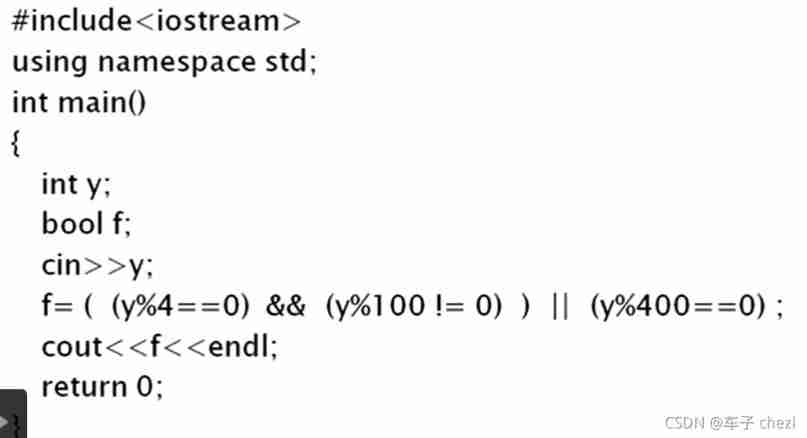
Why is 1900 not a leap year

Shell script
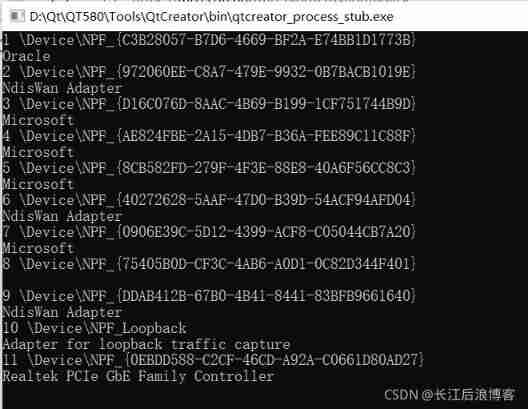
Soem EtherCAT source code analysis attachment 1 (establishment of communication operation environment)
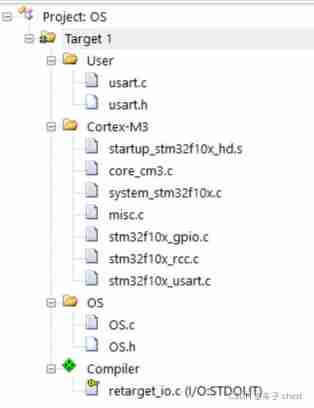
Explain task scheduling based on Cortex-M3 in detail (Part 2)
![Measurement fitting based on Halcon learning [III] PM_ measure_ board. Hdev routine](/img/f9/fc4f0bbce36b3c1368d838d723b027.jpg)
Measurement fitting based on Halcon learning [III] PM_ measure_ board. Hdev routine

Solutions to compilation warnings in Quartus II
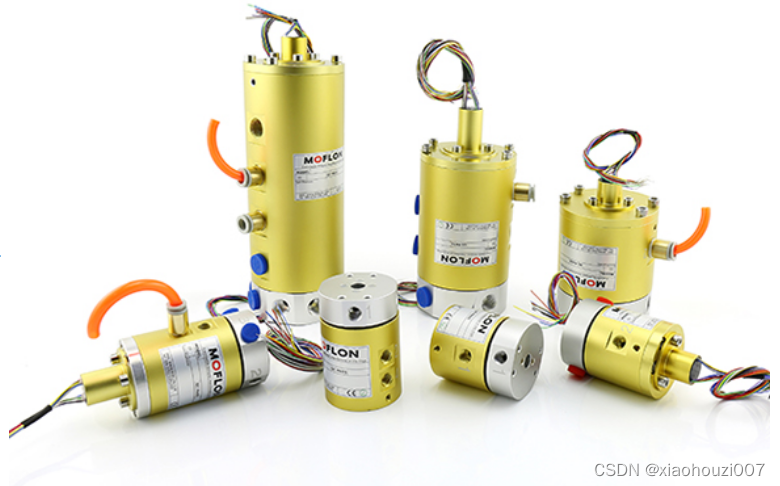
How to select conductive slip ring
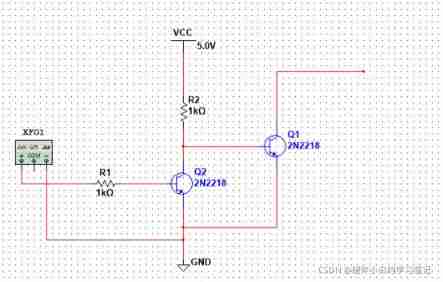
OC and OD gate circuit
![Shape template matching based on Halcon learning [VII] reuse_ model. Hdev routine](/img/55/0f05291755dc1c3c03db8e991a1ba1.jpg)
Shape template matching based on Halcon learning [VII] reuse_ model. Hdev routine

Simple design description of MIC circuit of ECM mobile phone
随机推荐
Hardware 1 -- relationship between gain and magnification
C WinForm [help interface - send email] - practice five
Sizeof (function name) =?
Matlab2018b problem solving when installing embedded coder support package for stmicroelectronic
C language # and #
STM32 --- serial port communication
Detailed summary of FIO test hard disk performance parameters and examples (with source code)
C WinForm [display real-time time in the status bar] - practical exercise 1
On boost circuit
Interview catalogue
Soem EtherCAT source code analysis attachment 1 (establishment of communication operation environment)
Shell script basic syntax
Management and use of DokuWiki
Stm32--- systick timer
Factors affecting the quality of slip rings in production
Working principle and type selection of common mode inductor
Explication de la procédure stockée pour SQL Server
Reasons for rapid wear of conductive slip rings
Fundamentals of C language
MHA High available Cluster for MySQL